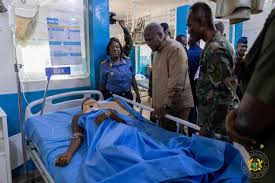The investigative committee examining the August 6 helicopter crash in Ghana has confirmed that there was no mid-air explosion. The blast occurred only when the aircraft hit the ground.
Presenting the findings on Tuesday, November 11, the committee’s leader, Captain (Rtd) Paul Forjoe, explained that the crash was caused by a sudden loss of altitude and lift due to a strong downdraft.
He clarified that although the helicopter lacked some modern safety features, this alone did not cause the accident.
“While modern enhancements would improve safety for our dignitaries and be welcomed by the Air Force, their absence does not explain this crash. It would be wrong to claim that,” Captain Forjoe said.
“Regarding the explosion, it occurred only on impact. The Z9 helicopter’s fuel tank, located beneath the passenger seats, was full at the time.”
The committee, established shortly after the crash, investigated technical, operational, and environmental factors contributing to the incident and issued recommendations to prevent future accidents.
The crash involved a Harbin Z-9EH military helicopter (tail number GHF 631) operated by the Ghana Air Force. The aircraft departed Accra at about 9:12 a.m. for an anti-illegal mining operation in Obuasi, Ashanti Region, before losing radar contact and crashing in the Adansi Akrofuom District.
All eight people on board were killed, including Defence Minister Dr. Edward Omane Boamah, Environment Minister Ibrahim Murtala Muhammed, Acting Deputy National Security Coordinator Muniru Mohammed Limuna, NDC Vice-Chair Samuel Sarpong, former parliamentary candidate Samuel Aboagye, Squadron Leader Peter Bafemi Anala, Flying Officer Manaen Twum Ampadu, and Sergeant Ernest Addo Mensah.
The investigation, led by National Security Coordinator Abdul-Osman Razak, involved the Ghana Air Force, Ghana Civil Aviation Authority (GCAA), and international aviation experts.
The committee recommended urgent safety upgrades for the Ghana Air Force, including acquiring modern aircraft with terrain avoidance systems and advanced navigation technologies. It also urged the installation of voice recorders, audiovisual flight data recorders, and simulators for recurrent pilot training.
Additional recommendations included developing en route navigational aids in remote areas, establishing flight data monitoring and tracking systems, and modernizing ground support equipment to enhance operational safety.
Implementing these measures, the committee noted, will strengthen Ghana’s aviation safety and help prevent future air disasters.















